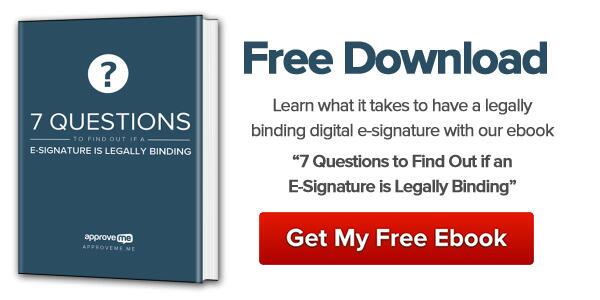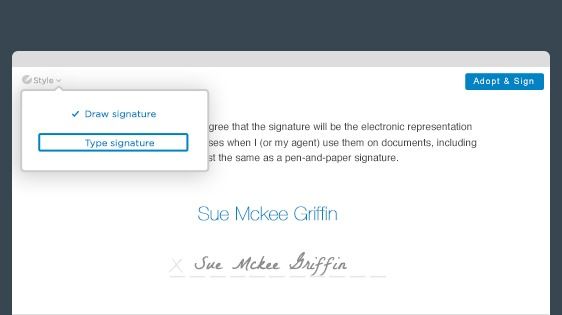What’s usually the big hold up in getting a deal completed?
More often than not delays revolve around getting the customer’s signature. This might be because the customer is not ready to sign, in which case your salespeople have more work to do. But it is often because the systems are not in place to allow the customer to effectively sign off. A bottle-neck results while the paperwork is printed out, faxed off, and goes back and forth with amendments. With re-printing, re-faxing and re-signing, this really can take days.
They can also help businesses ‘close’ deals quicker, improving cash-flow and increasing sales.
But the e-signature process needs to be prepared correctly in order for you to truly go paperless and reap all the benefits. Below we look at how to do that without the pain.
E-Signatures: The Technology
E-signature technology allows both B2B and B2C companies to prepare documentation, email it off to their customers and have it signed and returned literally within minutes. In retail situations, customers can sign up electronically to promotional deals instantly and without the need for long paper contracts.
The technology generally works using these four simple steps:
- A document is uploaded to a website (either yours or a third party online e-signature service) and tagged with annotations to indicate where signatures will need to go
- This marked file is sent to your specified recipients
- The recipient signs it either by choosing a cursive font or by ‘scrawling’ with their mouse ( or finger on a tablet)
- The signed file is sent back to you
This simple, electronic signature process is a long-overdue answer to the time-consuming and inefficient traditional methods of signing agreements; and the sector is booming – in fact it is on track to exceed $5 billion by the end of the decade.
Overcoming Legal Problems
The main obstacle to e-signatures is ensuring that they pass legal muster. Will they stand up in court, if challenged? Care and attention needs to go into the detail, and this is where some businesses fall down.
You can refer to this previous blog post about one such case where a well-known retailer hadn’t taken the necessary steps to ensure that the e-signatures they were collecting were legally binding.
We previously prepared a free download about how to make a signature legally binding. The seven main areas that you must address are: signature should identify
- Know who signed the document – without possibility of forgery to either the signature or the content
- Make sure you can prove that they signed it
- Ensure that the signatory of the document intended their action
- Include necessary disclosure and consent information
- Ensure that the document has not been tampered with in any way
- Make the document available to all signatories for a stated period of time (this may be regulated)
- Make sure you use dedicated e-signature software rather than form-generation plug-ins
If you address each of the above then your e-signature will be as watertight as any paper contract.
In 2000, the U.S. government’s ESIGN Act ensured that e-signatures have the same legal weight as handwritten ones; indeed federal judges use PDF software to e-sign their orders; but it takes attention to the fine details to ensure that’s the case.
WP E-Signature provides the following features to satisfy all legal requirements:
- Multiple, immediate, and online authentication add-ons that can be customized to fit the exposure of an agreement.
- A detailed audit report with irrefutable analytics for each signed transaction.
- A signing agreement worded in standard language, with a two-step authentication process for every signature.
- A proprietary authentication process which tracks the original encrypted document contents using your website. The document will not be accessible if the original document data (in its encrypted form) is not 100% the same.
- Once a document has been signed a copy of the signed document and a detailed audit trail is available to the signers using your website.
Can you use e-signatures for all documents?
You can use e-signatures for virtually all documents. There may be the one or two legal documents that you would prefer to keep on paper, such as a major financial transaction, last will and testament, or any document that needs notarization. But most business contracts can be finalized using e-signature technology.
Where notarization is required, you may find that e-signatures co-exist alongside paper signatures, and you may have to use both ways. Many organizations are in a state of ‘limbo’ with this at present.
Standard contracts prepared using the right e-signature software make life significantly easier for customers and business owners. It reduces waiting times, speeds up transactions, saves money and paper, and can increase sales.
Which e-signature software?
Most e-signature software charges monthly fees, limits user numbers, and forces customers to sign documents on a third-party website.
WP E-Signature by ApproveMe offers unlimited users on our business license, and allows you to get documents legally signed by your customer on your own website. It is also highly customizable, with add-on features that you can pick and choose as you see fit.
Find out more about WP E-Signature here


Smash this button if you’re ready to trade administration drudgery for more free-time.




